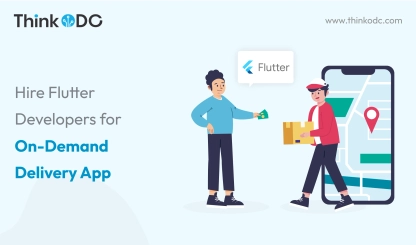We live in a world where users expect a seamless experience across devices. Whether sitting at a desktop, tablet in hand on the couch or checking notifications on a smartwatch, people want apps that work consistently wherever they are.
Developing separate native apps for each platform is no longer sustainable. Companies end up with bloated codebases that take more time, money and effort to build and maintain.
What if there is a solution for that?
Flutter - an open-source UI toolkit launched by Google in 2017. In a short span of 6 years, Flutter has taken the cross-platform app development world by storm. Developers have fallen in love with its hot reload capability, native performance, abundant widgets and speed of development.
As adoption continues to accelerate, 2024 is poised to be the year Flutter cements itself as the tool of choice for cross-platform magic.
Let's look at 10 compelling reasons why Flutter will rule supreme in the world of multi-experience development.

Hot reload and hot restart
One of Flutter's most game-changing features, hot reload enables you to make changes to your code and see the results instantly without restarting your app or losing state. Instead of the tedious compile-run cycles of traditional development, you get near-instant feedback as you build UIs.
Tweaking colors, testing interactions or adding features occurs in a matter of seconds. Design iterations, UI polishing and prototyping are faster than ever before. For quick validation of ideas before writing production-ready code, hot reload is a massive boost.
The productivity gains from this revolutionary rapid development cycle are hard to overstate. Hot reload accelerates everything from simple UI tweaks to substantial visual changes. It makes developers exponentially more efficient compared to native platforms.
Native-like performance
Cross-platform frameworks have gained a bad reputation for being sluggish compared to native. However, Flutter breaks all stereotypes by leveraging the native rendering engines of the host platform.
This allows Flutter apps to achieve the same smooth 60fps animations and scrolling performance as native apps.
Flutter uses Skia, a 2D graphic library, to draw widgets and manipulate their properties. The vector-based rendering means no slow bitmap blitting.
Combined with Flutter's reactive style framework, you get silky animation timing indistinguishable from native experiences.
App users have come to expect fluid visual effects as basic requirements. By delivering native-level FPS stats, Flutter ensures your users enjoy stutter-free UIs with lower chances of churn.
Expressive and declarative UI
At the heart of Flutter's design language are widgets. Instead of dealing with clunky view hierarchies and XML layouts, everything in Flutter is a widget. UI developers think in terms of widget trees rather than nested views.
Widgets capture both behavior and presentation logic in one place. Each widget manages its own configurable state which gets reflected onto the screen via the build method.
This declarative style of UI construction makes visual code more readable for developers. Widgets also compose together cleanly allowing extensive code reuse. Want to customize a widget? Just wrap it with a higher-level one and tweak it away!
The widget catalog covers all UI needs from text, images and icons to complex interaction patterns. Flutter cuts down UI code drastically compared to native platforms.
Read More: Why Flutter is the Perfect Match for Your Next Healthcare App
Rich ecosystem and community
Beyond Flutter's expansive core widgets, developers can tap into a thriving third-party ecosystem. Pub.dev, Flutter's package manager, lists close to 33,000 packages for common mobile app functionality like payments, location, augmented reality, messaging and more.
Active plugin contributors ensure the catalog keeps expanding. Most native SDKs and APIs find Flutter compatibility via community-driven ports. And thanks to Dart's easy interoperability with native code, any missing bridge can be built with moderate effort.
Vibrant developer communities foster knowledge sharing and collective growth. Stuck on a problem? A quick Google search will lead to detailed GitHub issues, StackOverflow threads or Discord chat servers. Chances are, someone has solved your roadblock before.
Compare this to learning niche native platforms with fragmented support resources. The unified Flutter community minimizes redundant effort with collective solutions.
Single codebase for all platforms
At its core, Flutter app development revolves around the philosophy of learning once, writing once and running everywhere. Unlike alternatives based on wrappers around native components, Flutter uses a single codebase architecture.
This means no more juggling platform-specific implementations. Whether building for iOS, Android, web or desktop, the same Dart code renders a unified UI. Roughly 80% of code can be shared across targets leading to substantial savings.
Take a Flutter developer building 5 different apps - maybe 2 mobile apps, a web app, a MacOS app and a Linux app. While a native approach would require 5 separate code bases in Swift/Kotlin, JS, Objective-C/Swift and platform-specific languages, Flutter lets you reuse most logic across all 5 apps.
The business implications are lowered costs, smaller teams and reduced time-to-market. For startups and enterprises alike looking for maximal output from minimal resources, Flutter transforms efficiency with cross-platform capabilities.
Ahead of the curve with emerging technologies
Beyond mature platforms like iOS and Android, Flutter has proved itself as the go-to solution for early adoption of cutting-edge technologies. Flutter for Web hit 1.0 in 2021, bringing slick web experiences backed by Dart compilation to native JavaScript.
As wearable devices continue to rise in popularity, developers use Flutter to target smartwatches. Embedding Flutter onto IoT devices like home appliances unlocks possibilities for companies exploring ambient computing.
Whether you're venturing into augmented reality, smart TVs or foldable devices, Flutter backs emerging form factors with portable code. Thanks to its hardware-agnostic renderer, Flutter future-proofs your apps for platforms still in their infancy today.
Open source and backed by google
As an open-source project, Flutter benefits from contributions big and small by developers across the globe. Dart and Flutter codes are available freely to the community, leading to direct involvement in its growth trajectory.
And backing Flutter is the tech giant Google itself. From the start, Google used Flutter to build many of its flagship apps like Stadia, Nest Hub, and Google Pay blending beautiful design with trademark smoothness.
Google's financial might and engineering muscle power Flutter's progress. Initiatives like Project Hummingbird help Flutter code compile to machine code for bare metal devices. The Silicon Valley giant’s long-term product visions shape Flutter’s rise as a dominant cross-platform framework for the future.
Reduced testing effort
Testing business logic across platforms typically means implementing everything multiple times. With Flutter’s single codebase structure, the bulk of app testing gets simplified.
Flutter integrates smoothly with unit and widget testing frameworks like mockito and flutter_test. Since most code gets reused across mobile, web and desktop, tests only need writing once. Automated UI testing via frameworks like Flutter Driver also helps validate flows across target platforms.
Setting up separate native test suites for iOS, Android and others raises both initial and maintenance costs over an app's lifecycle. With Flutter, the testing pyramid sees consolidation, saving time for developers and money for managers.
Growing demand and talent pool
As Flutter adoption spikes among startups and enterprises alike, so does demand for Flutter experts. LinkedIn lists over 2000+ openings per day globally requiring Flutter skills, spanning early-stage startups to tech giants.
In response, developers are rapidly skilling up in Flutter via official documentation, YouTube crash courses, dedicated boot camps and hands-on tutorials. Both experienced mobile devs, as well as aspiring newcomers, realize the game-changing appeal of learning Flutter.
With Dart’s beginner-friendly syntax picked up quickly by programmers from any background, the talent pool sees continuous expansion. Economic realities like decreased outsourcing costs also encourage companies to hire Flutter developers, especially in emerging markets.
The future is multi-platform
We now live in a multi-device world with users spending time across smartphones, laptops, tablets and smart home devices interchangeably. The lines between mobile, web and desktop grow ever fainter.
Users expect persistent experiences as they switch screens - whether it's continuing an article halfway read on the phone onto a desktop browser or resuming a movie on a tablet from the same timestamp as a smart TV.
Building these seamless, unified app experiences requires thinking beyond native code and single-platform limitations. Flutter lets developers realize multi-experience ambitions with portable UI code tailored to each form factor.
One codebase layered across platforms not only delights users but also saves substantial developer resources. As multi-experience development goes mainstream, Flutter paves the path ahead with elegant syntax and high performance.
Conclusion
It is clear that Flutter is primed to dominate the cross-platform mobile app development landscape in the coming years. Its winning combination of hot reload capability, native performance, expressive UI framework, extensive libraries and tools, unified codebase support, cutting-edge platform support, Google backing, easier testing and surging talent availability make it a force to be reckoned with.
As businesses look to capitalize on multi-experience strategies spanning different devices, choosing Flutter can give them the best possible head start. With support for current and next-gen platforms, Flutter future-proofs development efforts allowing smart companies to stay ahead of the curve.
If you are starting a new project, we highly encourage you to explore Flutter first-hand to realize the game-changing benefits it brings to the table.
Hire Flutter offshore developers or upskill your teams to ride this wave. In the world of cross-platform development, all signs point towards Flutter becoming the default choice moving forward.





